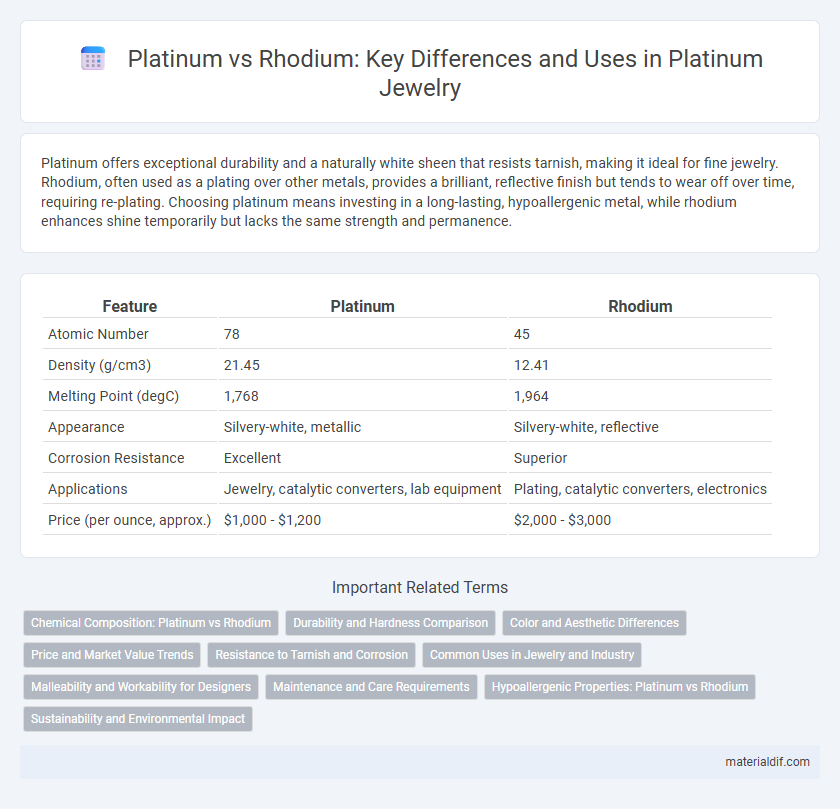Platinum offers exceptional durability and a naturally white sheen that resists tarnish, making it ideal for fine jewelry. Rhodium, often used as a plating over other metals, provides a brilliant, reflective finish but tends to wear off over time, requiring re-plating. Choosing platinum means investing in a long-lasting, hypoallergenic metal, while rhodium enhances shine temporarily but lacks the same strength and permanence.
Table of Comparison
| Feature | Platinum | Rhodium |
|---|---|---|
| Atomic Number | 78 | 45 |
| Density (g/cm3) | 21.45 | 12.41 |
| Melting Point (degC) | 1,768 | 1,964 |
| Appearance | Silvery-white, metallic | Silvery-white, reflective |
| Corrosion Resistance | Excellent | Superior |
| Applications | Jewelry, catalytic converters, lab equipment | Plating, catalytic converters, electronics |
| Price (per ounce, approx.) | $1,000 - $1,200 | $2,000 - $3,000 |
Chemical Composition: Platinum vs Rhodium
Platinum and rhodium are both members of the platinum group metals, sharing similar chemical properties due to their position in group 10 and period 5 and 6 of the periodic table, with platinum having the atomic number 78 and rhodium 45. Platinum's chemical composition includes a face-centered cubic crystal structure, making it highly stable and resistant to corrosion, while rhodium exhibits a hexagonal close-packed structure that contributes to its exceptional hardness and high reflectance. Both metals are chemically inert but differ in oxidation states; platinum commonly exhibits +2 and +4 states, whereas rhodium is more versatile with oxidation states ranging from 0 to +7 in various chemical compounds.
Durability and Hardness Comparison
Platinum exhibits a Mohs hardness of approximately 4 to 4.5, making it softer but more malleable compared to rhodium, which has a hardness around 6.5 to 7. Rhodium's superior hardness contributes to higher scratch resistance and durability, commonly used as a plating to protect softer metals like platinum. Platinum's density and ability to withstand wear over time make it ideal for jewelry that retains its luster despite daily use.
Color and Aesthetic Differences
Platinum features a naturally white-silver color with a subtle, slightly grayish hue, providing a subdued elegance often favored in classic jewelry designs. Rhodium, on the other hand, offers a bright, reflective white shine with a cooler tone and superior brilliance, making it a popular choice for enhancing the luster of white gold and silver pieces. While platinum develops a soft patina over time that adds vintage charm, rhodium plating can wear off and requires periodic reapplication to maintain its vibrant appearance.
Price and Market Value Trends
Platinum typically trades at a lower price point compared to rhodium due to its higher availability and broader industrial applications. Rhodium's market value experiences more volatility, frequently surpassing platinum during periods of increased demand in the automotive catalytic converter sector. Investment trends indicate growing interest in rhodium for its scarcity and price spikes, whereas platinum remains favored for jewelry and catalytic processes.
Resistance to Tarnish and Corrosion
Platinum exhibits exceptional resistance to tarnish and corrosion, maintaining its luster even in harsh environments due to its dense molecular structure and inert properties. Rhodium, while also resistant to oxidation and corrosion, tends to be more reactive than platinum, especially when exposed to high heat or acidic conditions. Consequently, platinum is often preferred for longevity and consistent appearance in jewelry and industrial applications.
Common Uses in Jewelry and Industry
Platinum and rhodium both serve crucial roles in jewelry, with platinum prized for its durability and naturally white luster, commonly used in engagement rings and high-end watches. Rhodium's primary use in jewelry is as a plating material to enhance the shine and scratch resistance of white gold and silver pieces. In industrial applications, platinum is essential for catalytic converters and laboratory equipment, while rhodium is mainly utilized in automotive catalytic converters due to its exceptional resistance to corrosion and high-temperature stability.
Malleability and Workability for Designers
Platinum exhibits superior malleability compared to rhodium, allowing designers to shape intricate and delicate jewelry pieces with greater ease. Its excellent workability ensures smooth forging and soldering, making it ideal for complex designs requiring detailed craftsmanship. Rhodium, while harder and more brittle, is primarily used as a durable plating material rather than for direct fabrication.
Maintenance and Care Requirements
Platinum requires regular cleaning to maintain its natural luster and is resistant to tarnish, making it relatively low-maintenance compared to Rhodium. Rhodium plating needs periodic reapplication due to wear and fading, especially on frequently worn jewelry. Both metals benefit from gentle cleaning with mild soap and water, but Rhodium demands more frequent professional upkeep to preserve its bright, reflective finish.
Hypoallergenic Properties: Platinum vs Rhodium
Platinum is highly valued for its superior hypoallergenic properties, making it an ideal choice for sensitive skin compared to rhodium, which can sometimes cause allergic reactions due to its alloy composition. Unlike rhodium, which is often used as a plating over other metals and may wear off exposing irritants, pure platinum maintains its hypoallergenic quality consistently over time. This durability and skin-friendly nature position platinum as the preferred metal for hypoallergenic jewelry.
Sustainability and Environmental Impact
Platinum and rhodium are both precious metals used in catalytic converters, but platinum's extraction and refining processes tend to have a lower environmental impact compared to rhodium, which is rarer and often associated with more intensive mining. Platinum mining typically results in reduced greenhouse gas emissions and less habitat disruption, contributing to better sustainability profiles. Recycling rates for platinum are higher, further minimizing its ecological footprint relative to rhodium.
Platinum vs Rhodium Infographic

 materialdif.com
materialdif.com